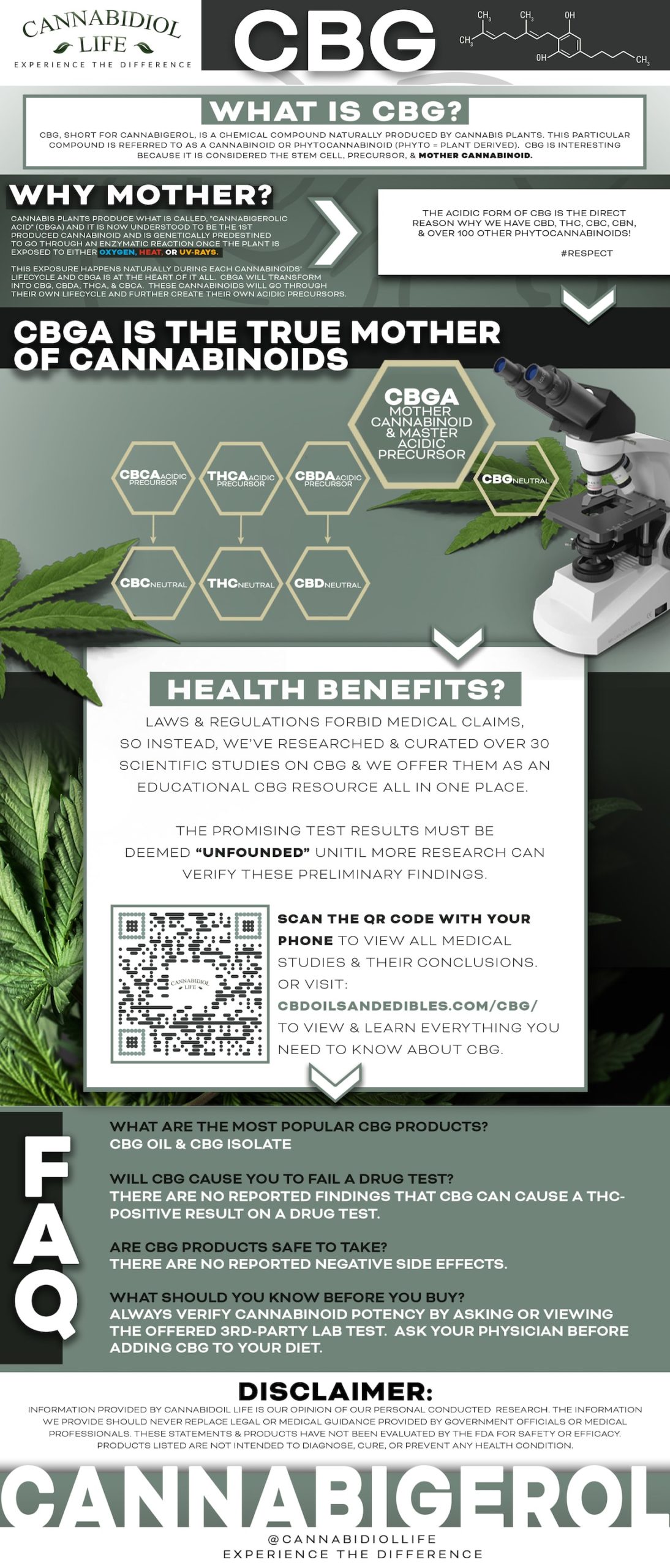Did you know?
Cannabidiol Life supports every person that wants or needs CBD via our free CBD Discount Program.
Join our 20,000+ other savvy CBD shoppers and get a 37% OFF COUPON immediately.
Not to be confused with the more popular cannabinoid CBD, CBG is quite different yet seems to share MANY of the same properties of CBD. Interestingly, there is official consensus among the scientific community that the potential of both CBG and its acidic form (CBGA) could actually be greater than CBD!
Not to be confused with the more popular cannabinoid, CBD, CBG is quite different yet seems to share many of the same properties in comparison to CBD. Interestingly, there is official dialogue among the scientific community that the potential of both CBG and its acidic form (CBGA) could actually be greater than CBD!
CBG is often described as the:

Hypothetically, let’s say I’m trying to sell you 10 GRAMS OF CBG isolate; 10 grams = 10,000 MG. For educational purposes, let’s say our CBG isolate 95% pure.
Now that we have the CBG percentage, we can accurately find out how many MG’s of CBG is actually inside the 10-gram CBG isolate jar.
Next, take the products’ milligram weight(10 grams = 10,000MG) and multiply it by the CBG percentage (95%) and since we’re dealing with percentages, you have to move the decimal over to the left by two positions.
The equation will look something like this:
10,000MG x 0.95 = 9,500 MG of CBG.
This is very important because without knowing the Cannabinoid percentage, you will not be able to compare one CBG isolate product to the next (quality-wise). The only thing you will be able to compare is the price.
Far too often, CBG consumers purchase inferior products or get robbed by false label claims by simply not checking the C.O.A.’s.
The moral of this short story here is don’t assume that the listed weight on the label is an automatic reference to the number of CBG/CBD within. It’s all about the percentage of cannabinoid purity.
CBG doses or serving sizes vary from one person to the next, but we’ve found a great way to figure out the formula for each and every person wanting or at least considering adding CBG to their diets.
I spoke with Dr. Rosado, MD, and author of Hope & Healing: A Case For Cannabis, and this is what he advised…
“CBG works best when used in a 1:1 ratio with CBD.”
Once we know how much CBD we should take, we’ll know exactly what our CBG dose will be. Now, in order to find the perfect CBD dosage, we must use the following CBD Dosage formula:
BODY WEIGHT X 0.325mg = Most Accurate CBD Dose
I’ll use myself as an example and show you step by step how to calculate your perfect CBG dosage. Since I weigh 200lbs, my specific formula will look like this:
200lbs x 0.325mg = 65mg of CBD
Given the 1:1 ratio (CBD to CBG), this tells me that my perfect CBG dose is 65mg and should be coupled with 65mg of CBD for the best possible results (based on current CBG research).
And that’s all there is to it!
We recommend two options:
Here is a quick example of how to properly use option 2 since there is a bit of mixing involved.
Let’s say you’ve purchased our USDA Certified Organic full-spectrum CBD oil 1,500mg. The next step would be to grab your CBG isolate and weigh out an equal portion of mg of CBG (1,500mg). Mix these two together and you now have a perfect 1 to 1 ratio of CBD to CBG.
Always store away of direct sunlight as well as in a cool and dry place. One study showed that failure to properly store your cannabis products could actually drastically affect their quality and the consumer could lose up to 40% of the cannabinoids claimed on the bottle.
Cannabidiol Life supports every person that wants or needs CBD via our free CBD Discount Program.
Join our 20,000+ other savvy CBD shoppers and get a 37% OFF COUPON immediately.